Evidence-Based Research: Nursing Preceptor Program Analysis
VerifiedAdded on 2022/08/28
|6
|1297
|16
Report
AI Summary
This report presents a literature review evaluating evidence-based research on nursing preceptor programs. The paper investigates the impact of these programs on mitigating nursing shortages and improving patient health outcomes, such as patient satisfaction and quality of care, within one year of implementation. The research utilizes the PICOT framework (Population, Intervention, Comparison, Outcome, Time) to analyze studies by Watkins, Hart and Mareno (2016), Aboshaiqah and Qasim (2018), and Robbins et al. (2017). The studies explore the programs' effects on nurses' competencies, psychological empowerment, and autonomy. The report also discusses study limitations, including the use of self-reported questionnaires and the need for more rigorous methodologies like randomization. The conclusion emphasizes the need for standardized metrics and further research to validate the effectiveness of nursing preceptor programs. References to relevant studies are included.
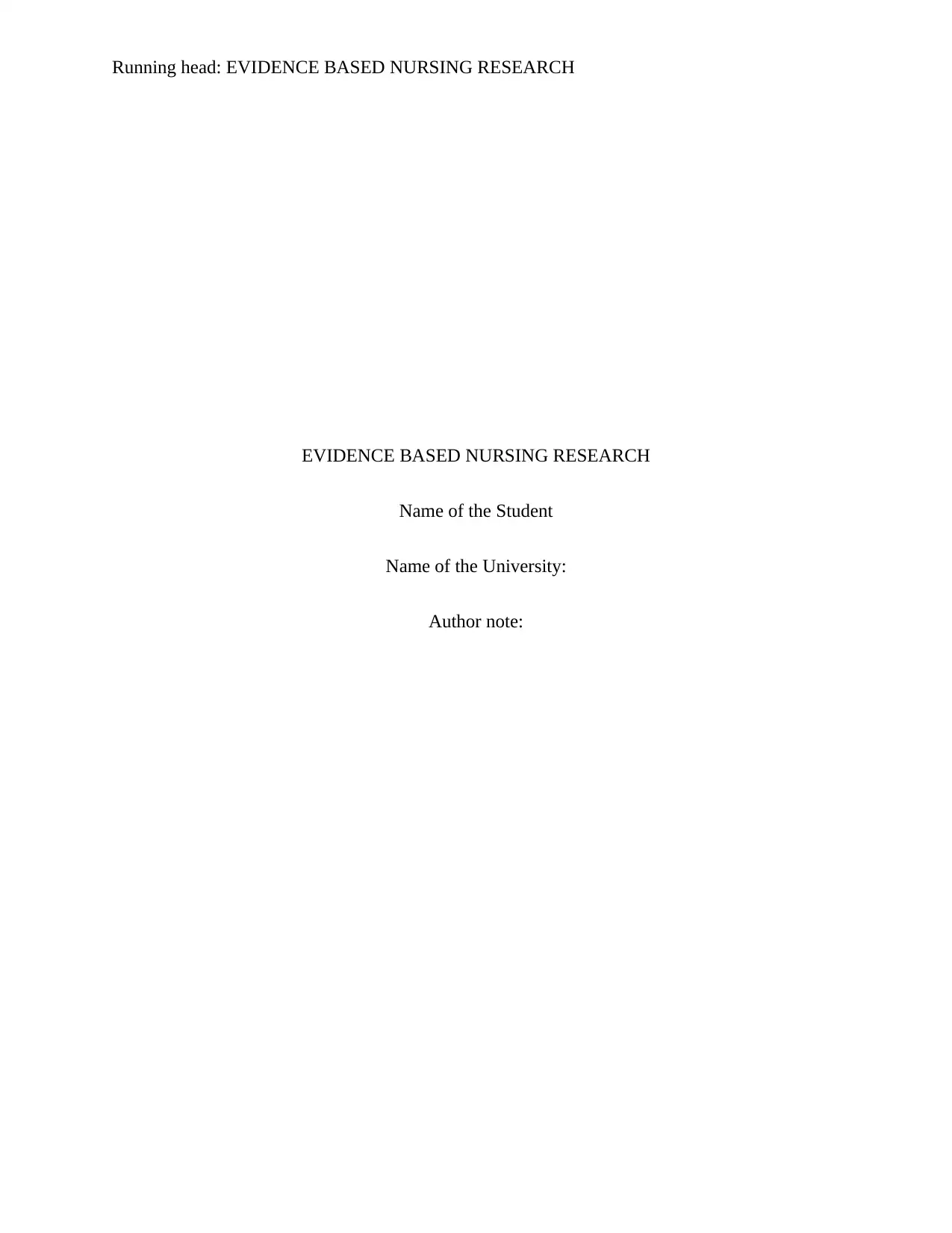
Running head: EVIDENCE BASED NURSING RESEARCH
EVIDENCE BASED NURSING RESEARCH
Name of the Student
Name of the University:
Author note:
EVIDENCE BASED NURSING RESEARCH
Name of the Student
Name of the University:
Author note:
Paraphrase This Document
Need a fresh take? Get an instant paraphrase of this document with our AI Paraphraser
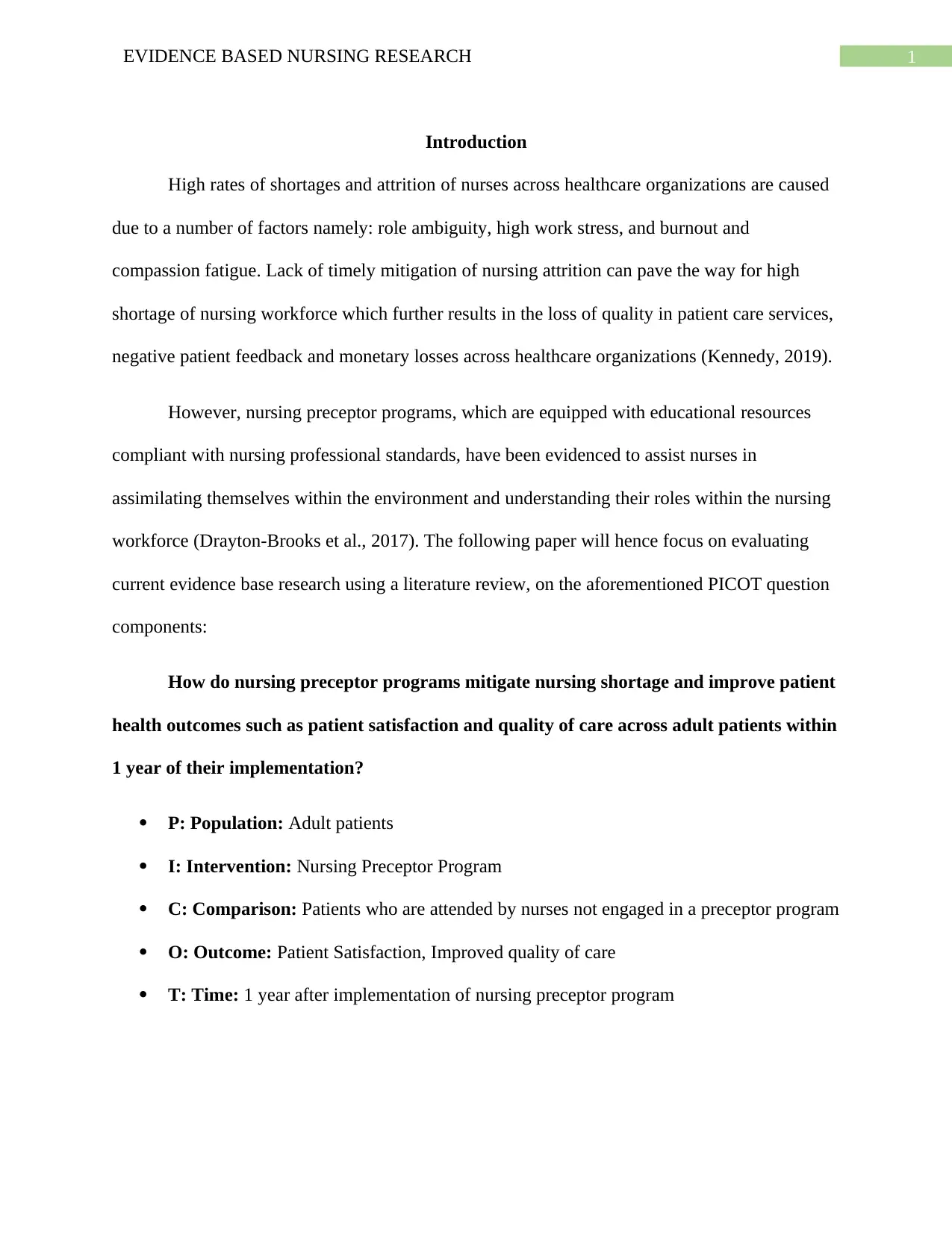
1EVIDENCE BASED NURSING RESEARCH
Introduction
High rates of shortages and attrition of nurses across healthcare organizations are caused
due to a number of factors namely: role ambiguity, high work stress, and burnout and
compassion fatigue. Lack of timely mitigation of nursing attrition can pave the way for high
shortage of nursing workforce which further results in the loss of quality in patient care services,
negative patient feedback and monetary losses across healthcare organizations (Kennedy, 2019).
However, nursing preceptor programs, which are equipped with educational resources
compliant with nursing professional standards, have been evidenced to assist nurses in
assimilating themselves within the environment and understanding their roles within the nursing
workforce (Drayton-Brooks et al., 2017). The following paper will hence focus on evaluating
current evidence base research using a literature review, on the aforementioned PICOT question
components:
How do nursing preceptor programs mitigate nursing shortage and improve patient
health outcomes such as patient satisfaction and quality of care across adult patients within
1 year of their implementation?
P: Population: Adult patients
I: Intervention: Nursing Preceptor Program
C: Comparison: Patients who are attended by nurses not engaged in a preceptor program
O: Outcome: Patient Satisfaction, Improved quality of care
T: Time: 1 year after implementation of nursing preceptor program
Introduction
High rates of shortages and attrition of nurses across healthcare organizations are caused
due to a number of factors namely: role ambiguity, high work stress, and burnout and
compassion fatigue. Lack of timely mitigation of nursing attrition can pave the way for high
shortage of nursing workforce which further results in the loss of quality in patient care services,
negative patient feedback and monetary losses across healthcare organizations (Kennedy, 2019).
However, nursing preceptor programs, which are equipped with educational resources
compliant with nursing professional standards, have been evidenced to assist nurses in
assimilating themselves within the environment and understanding their roles within the nursing
workforce (Drayton-Brooks et al., 2017). The following paper will hence focus on evaluating
current evidence base research using a literature review, on the aforementioned PICOT question
components:
How do nursing preceptor programs mitigate nursing shortage and improve patient
health outcomes such as patient satisfaction and quality of care across adult patients within
1 year of their implementation?
P: Population: Adult patients
I: Intervention: Nursing Preceptor Program
C: Comparison: Patients who are attended by nurses not engaged in a preceptor program
O: Outcome: Patient Satisfaction, Improved quality of care
T: Time: 1 year after implementation of nursing preceptor program
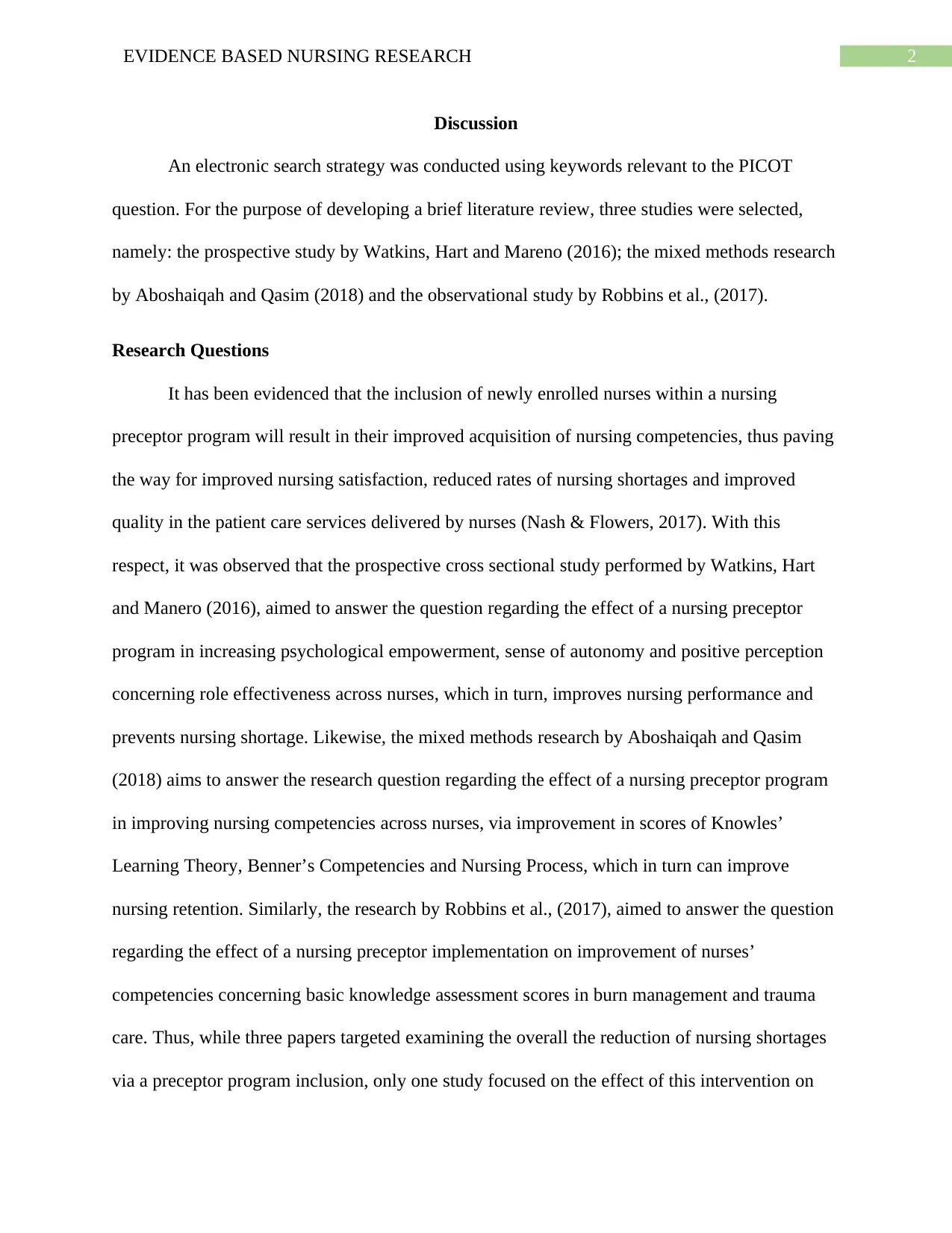
2EVIDENCE BASED NURSING RESEARCH
Discussion
An electronic search strategy was conducted using keywords relevant to the PICOT
question. For the purpose of developing a brief literature review, three studies were selected,
namely: the prospective study by Watkins, Hart and Mareno (2016); the mixed methods research
by Aboshaiqah and Qasim (2018) and the observational study by Robbins et al., (2017).
Research Questions
It has been evidenced that the inclusion of newly enrolled nurses within a nursing
preceptor program will result in their improved acquisition of nursing competencies, thus paving
the way for improved nursing satisfaction, reduced rates of nursing shortages and improved
quality in the patient care services delivered by nurses (Nash & Flowers, 2017). With this
respect, it was observed that the prospective cross sectional study performed by Watkins, Hart
and Manero (2016), aimed to answer the question regarding the effect of a nursing preceptor
program in increasing psychological empowerment, sense of autonomy and positive perception
concerning role effectiveness across nurses, which in turn, improves nursing performance and
prevents nursing shortage. Likewise, the mixed methods research by Aboshaiqah and Qasim
(2018) aims to answer the research question regarding the effect of a nursing preceptor program
in improving nursing competencies across nurses, via improvement in scores of Knowles’
Learning Theory, Benner’s Competencies and Nursing Process, which in turn can improve
nursing retention. Similarly, the research by Robbins et al., (2017), aimed to answer the question
regarding the effect of a nursing preceptor implementation on improvement of nurses’
competencies concerning basic knowledge assessment scores in burn management and trauma
care. Thus, while three papers targeted examining the overall the reduction of nursing shortages
via a preceptor program inclusion, only one study focused on the effect of this intervention on
Discussion
An electronic search strategy was conducted using keywords relevant to the PICOT
question. For the purpose of developing a brief literature review, three studies were selected,
namely: the prospective study by Watkins, Hart and Mareno (2016); the mixed methods research
by Aboshaiqah and Qasim (2018) and the observational study by Robbins et al., (2017).
Research Questions
It has been evidenced that the inclusion of newly enrolled nurses within a nursing
preceptor program will result in their improved acquisition of nursing competencies, thus paving
the way for improved nursing satisfaction, reduced rates of nursing shortages and improved
quality in the patient care services delivered by nurses (Nash & Flowers, 2017). With this
respect, it was observed that the prospective cross sectional study performed by Watkins, Hart
and Manero (2016), aimed to answer the question regarding the effect of a nursing preceptor
program in increasing psychological empowerment, sense of autonomy and positive perception
concerning role effectiveness across nurses, which in turn, improves nursing performance and
prevents nursing shortage. Likewise, the mixed methods research by Aboshaiqah and Qasim
(2018) aims to answer the research question regarding the effect of a nursing preceptor program
in improving nursing competencies across nurses, via improvement in scores of Knowles’
Learning Theory, Benner’s Competencies and Nursing Process, which in turn can improve
nursing retention. Similarly, the research by Robbins et al., (2017), aimed to answer the question
regarding the effect of a nursing preceptor implementation on improvement of nurses’
competencies concerning basic knowledge assessment scores in burn management and trauma
care. Thus, while three papers targeted examining the overall the reduction of nursing shortages
via a preceptor program inclusion, only one study focused on the effect of this intervention on
⊘ This is a preview!⊘
Do you want full access?
Subscribe today to unlock all pages.

Trusted by 1+ million students worldwide
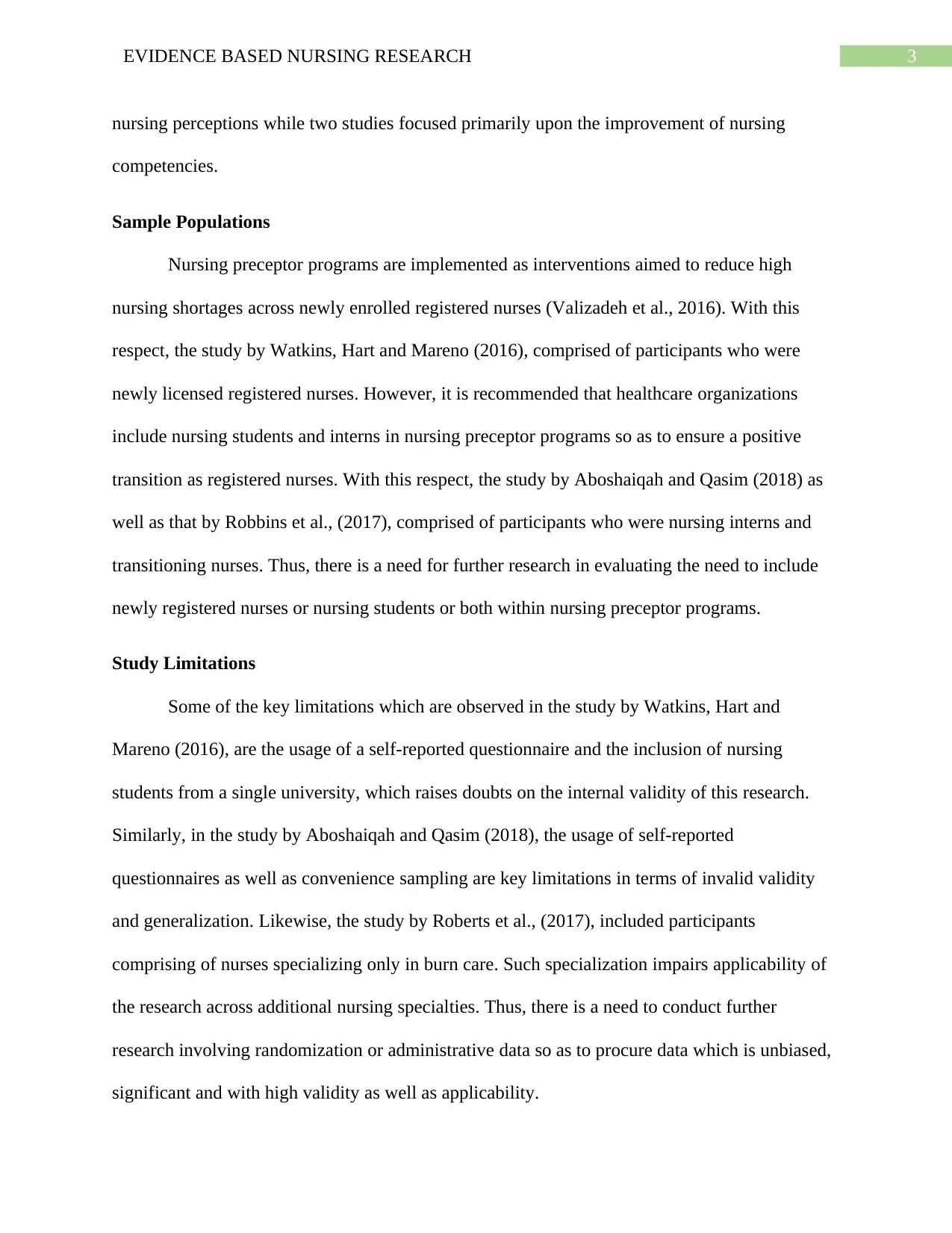
3EVIDENCE BASED NURSING RESEARCH
nursing perceptions while two studies focused primarily upon the improvement of nursing
competencies.
Sample Populations
Nursing preceptor programs are implemented as interventions aimed to reduce high
nursing shortages across newly enrolled registered nurses (Valizadeh et al., 2016). With this
respect, the study by Watkins, Hart and Mareno (2016), comprised of participants who were
newly licensed registered nurses. However, it is recommended that healthcare organizations
include nursing students and interns in nursing preceptor programs so as to ensure a positive
transition as registered nurses. With this respect, the study by Aboshaiqah and Qasim (2018) as
well as that by Robbins et al., (2017), comprised of participants who were nursing interns and
transitioning nurses. Thus, there is a need for further research in evaluating the need to include
newly registered nurses or nursing students or both within nursing preceptor programs.
Study Limitations
Some of the key limitations which are observed in the study by Watkins, Hart and
Mareno (2016), are the usage of a self-reported questionnaire and the inclusion of nursing
students from a single university, which raises doubts on the internal validity of this research.
Similarly, in the study by Aboshaiqah and Qasim (2018), the usage of self-reported
questionnaires as well as convenience sampling are key limitations in terms of invalid validity
and generalization. Likewise, the study by Roberts et al., (2017), included participants
comprising of nurses specializing only in burn care. Such specialization impairs applicability of
the research across additional nursing specialties. Thus, there is a need to conduct further
research involving randomization or administrative data so as to procure data which is unbiased,
significant and with high validity as well as applicability.
nursing perceptions while two studies focused primarily upon the improvement of nursing
competencies.
Sample Populations
Nursing preceptor programs are implemented as interventions aimed to reduce high
nursing shortages across newly enrolled registered nurses (Valizadeh et al., 2016). With this
respect, the study by Watkins, Hart and Mareno (2016), comprised of participants who were
newly licensed registered nurses. However, it is recommended that healthcare organizations
include nursing students and interns in nursing preceptor programs so as to ensure a positive
transition as registered nurses. With this respect, the study by Aboshaiqah and Qasim (2018) as
well as that by Robbins et al., (2017), comprised of participants who were nursing interns and
transitioning nurses. Thus, there is a need for further research in evaluating the need to include
newly registered nurses or nursing students or both within nursing preceptor programs.
Study Limitations
Some of the key limitations which are observed in the study by Watkins, Hart and
Mareno (2016), are the usage of a self-reported questionnaire and the inclusion of nursing
students from a single university, which raises doubts on the internal validity of this research.
Similarly, in the study by Aboshaiqah and Qasim (2018), the usage of self-reported
questionnaires as well as convenience sampling are key limitations in terms of invalid validity
and generalization. Likewise, the study by Roberts et al., (2017), included participants
comprising of nurses specializing only in burn care. Such specialization impairs applicability of
the research across additional nursing specialties. Thus, there is a need to conduct further
research involving randomization or administrative data so as to procure data which is unbiased,
significant and with high validity as well as applicability.
Paraphrase This Document
Need a fresh take? Get an instant paraphrase of this document with our AI Paraphraser
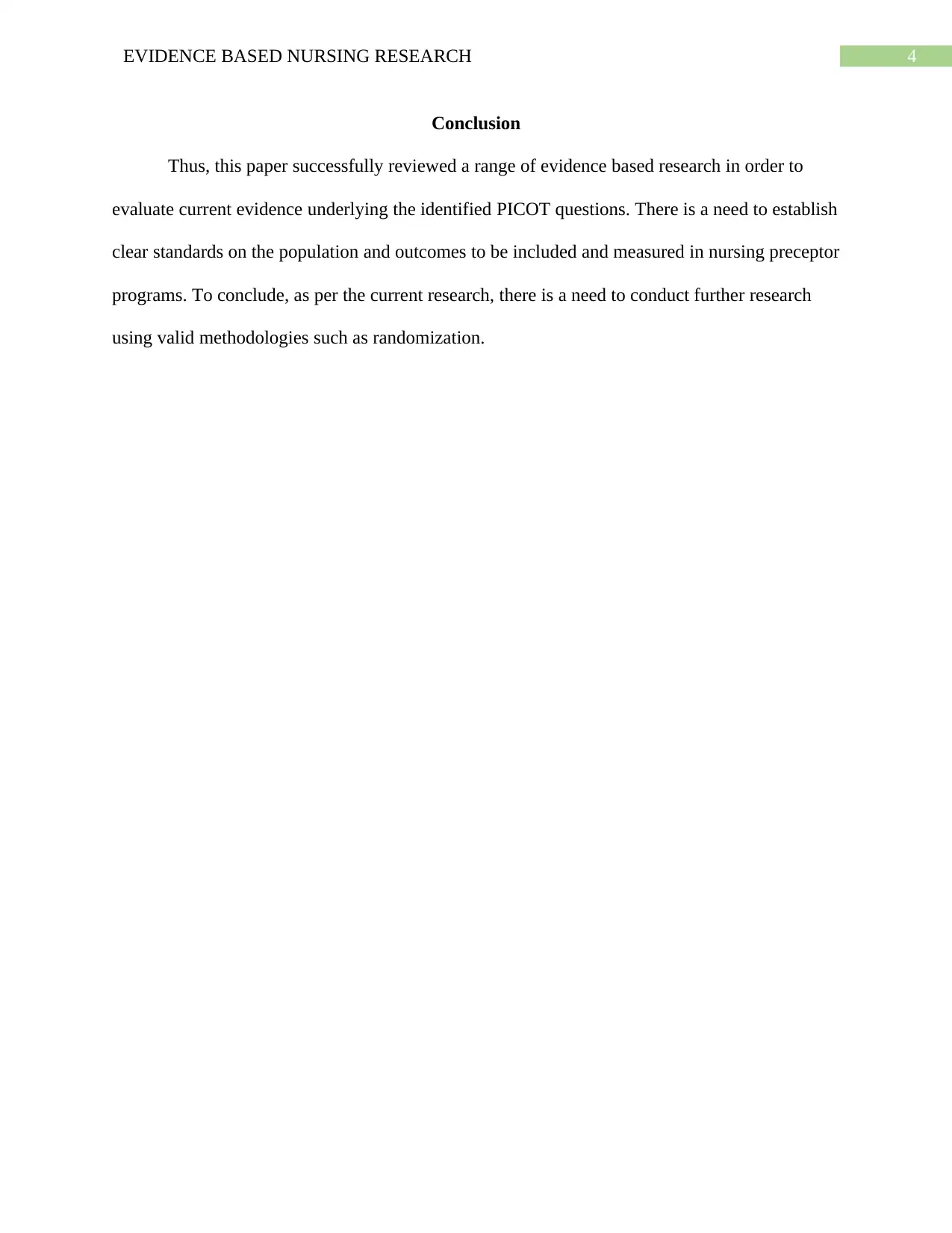
4EVIDENCE BASED NURSING RESEARCH
Conclusion
Thus, this paper successfully reviewed a range of evidence based research in order to
evaluate current evidence underlying the identified PICOT questions. There is a need to establish
clear standards on the population and outcomes to be included and measured in nursing preceptor
programs. To conclude, as per the current research, there is a need to conduct further research
using valid methodologies such as randomization.
Conclusion
Thus, this paper successfully reviewed a range of evidence based research in order to
evaluate current evidence underlying the identified PICOT questions. There is a need to establish
clear standards on the population and outcomes to be included and measured in nursing preceptor
programs. To conclude, as per the current research, there is a need to conduct further research
using valid methodologies such as randomization.
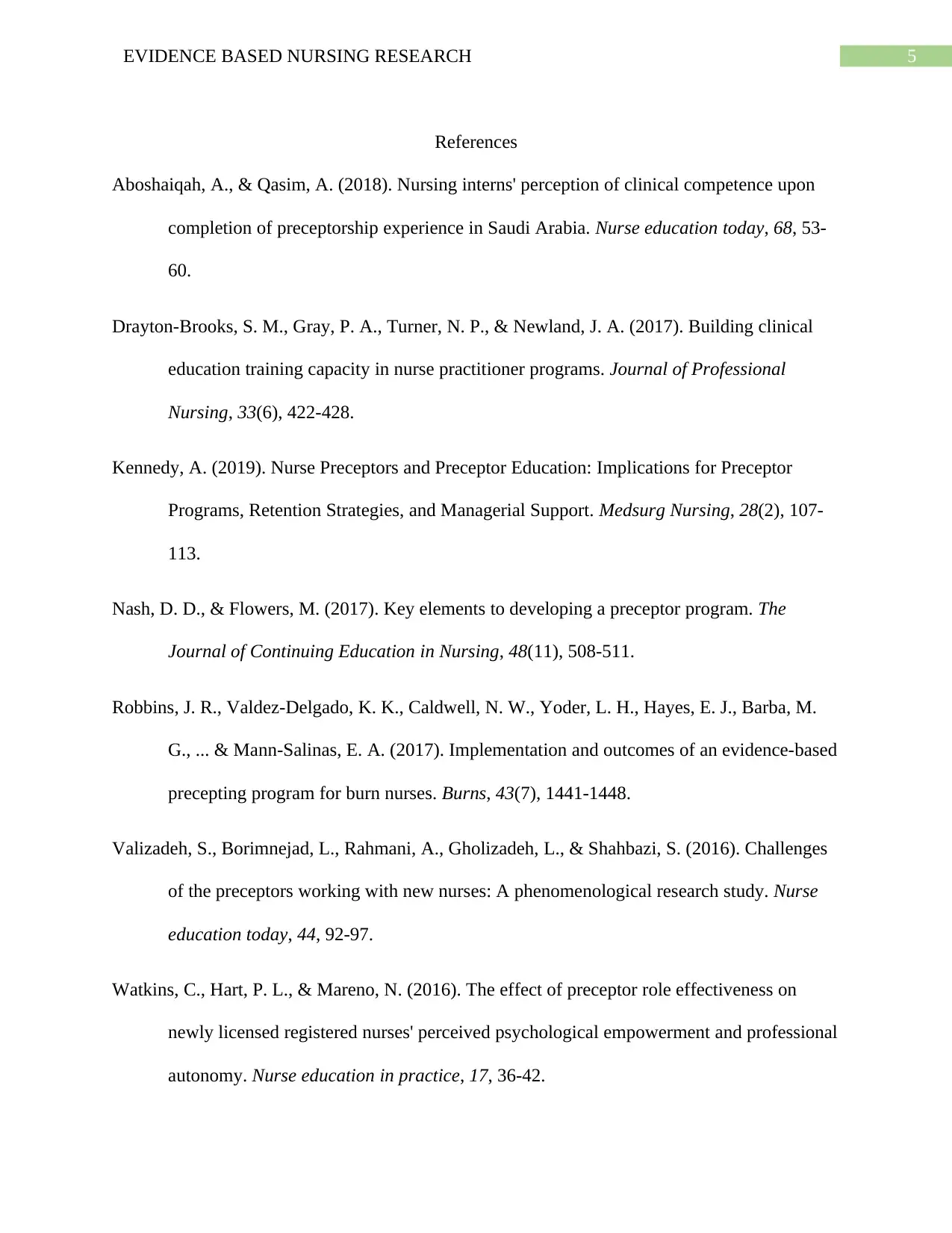
5EVIDENCE BASED NURSING RESEARCH
References
Aboshaiqah, A., & Qasim, A. (2018). Nursing interns' perception of clinical competence upon
completion of preceptorship experience in Saudi Arabia. Nurse education today, 68, 53-
60.
Drayton-Brooks, S. M., Gray, P. A., Turner, N. P., & Newland, J. A. (2017). Building clinical
education training capacity in nurse practitioner programs. Journal of Professional
Nursing, 33(6), 422-428.
Kennedy, A. (2019). Nurse Preceptors and Preceptor Education: Implications for Preceptor
Programs, Retention Strategies, and Managerial Support. Medsurg Nursing, 28(2), 107-
113.
Nash, D. D., & Flowers, M. (2017). Key elements to developing a preceptor program. The
Journal of Continuing Education in Nursing, 48(11), 508-511.
Robbins, J. R., Valdez-Delgado, K. K., Caldwell, N. W., Yoder, L. H., Hayes, E. J., Barba, M.
G., ... & Mann-Salinas, E. A. (2017). Implementation and outcomes of an evidence-based
precepting program for burn nurses. Burns, 43(7), 1441-1448.
Valizadeh, S., Borimnejad, L., Rahmani, A., Gholizadeh, L., & Shahbazi, S. (2016). Challenges
of the preceptors working with new nurses: A phenomenological research study. Nurse
education today, 44, 92-97.
Watkins, C., Hart, P. L., & Mareno, N. (2016). The effect of preceptor role effectiveness on
newly licensed registered nurses' perceived psychological empowerment and professional
autonomy. Nurse education in practice, 17, 36-42.
References
Aboshaiqah, A., & Qasim, A. (2018). Nursing interns' perception of clinical competence upon
completion of preceptorship experience in Saudi Arabia. Nurse education today, 68, 53-
60.
Drayton-Brooks, S. M., Gray, P. A., Turner, N. P., & Newland, J. A. (2017). Building clinical
education training capacity in nurse practitioner programs. Journal of Professional
Nursing, 33(6), 422-428.
Kennedy, A. (2019). Nurse Preceptors and Preceptor Education: Implications for Preceptor
Programs, Retention Strategies, and Managerial Support. Medsurg Nursing, 28(2), 107-
113.
Nash, D. D., & Flowers, M. (2017). Key elements to developing a preceptor program. The
Journal of Continuing Education in Nursing, 48(11), 508-511.
Robbins, J. R., Valdez-Delgado, K. K., Caldwell, N. W., Yoder, L. H., Hayes, E. J., Barba, M.
G., ... & Mann-Salinas, E. A. (2017). Implementation and outcomes of an evidence-based
precepting program for burn nurses. Burns, 43(7), 1441-1448.
Valizadeh, S., Borimnejad, L., Rahmani, A., Gholizadeh, L., & Shahbazi, S. (2016). Challenges
of the preceptors working with new nurses: A phenomenological research study. Nurse
education today, 44, 92-97.
Watkins, C., Hart, P. L., & Mareno, N. (2016). The effect of preceptor role effectiveness on
newly licensed registered nurses' perceived psychological empowerment and professional
autonomy. Nurse education in practice, 17, 36-42.
⊘ This is a preview!⊘
Do you want full access?
Subscribe today to unlock all pages.

Trusted by 1+ million students worldwide
1 out of 6
Your All-in-One AI-Powered Toolkit for Academic Success.
+13062052269
info@desklib.com
Available 24*7 on WhatsApp / Email
![[object Object]](/_next/static/media/star-bottom.7253800d.svg)
Unlock your academic potential
Copyright © 2020–2025 A2Z Services. All Rights Reserved. Developed and managed by ZUCOL.
